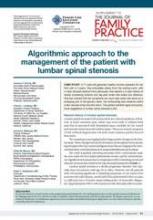User login
This supplement provides recommendations from a consensus panel of experts on how to treat and manage LSS, including assessment and diagnosis and surgical and non-surgical treatment plans. The supplement also includes a detailed LSS management algorithm for use by the family physician.
This supplement provides recommendations from a consensus panel of experts on how to treat and manage LSS, including assessment and diagnosis and surgical and non-surgical treatment plans. The supplement also includes a detailed LSS management algorithm for use by the family physician.
This supplement provides recommendations from a consensus panel of experts on how to treat and manage LSS, including assessment and diagnosis and surgical and non-surgical treatment plans. The supplement also includes a detailed LSS management algorithm for use by the family physician.
DISCLOSURES
Dr. Doorly reports he was previously on the speakers bureau for Medtronic. Dr. Lambing reports she is on the speakers bureau for Medtronic. Dr. Malanga reports he is on advisory boards of Cephalon, Endo Pharmaceuticals, and Forest Laboratories. Dr. Maurer reports he is a consultant for Medtronic. Dr. Rashbaum reports he receives royalties and intellectual property rights from, is on the advisory board of, and has ownership interest in Medtronic. This supplement to The Journal of Family Practice was sponsored by the Primary Care Education Consortium and was supported by an educational grant from Medtronic.
This supplement to The Journal of Family Practice was sponsored by the Primary Care Education Consortium and was supported by an educational grant from Medtronic.

